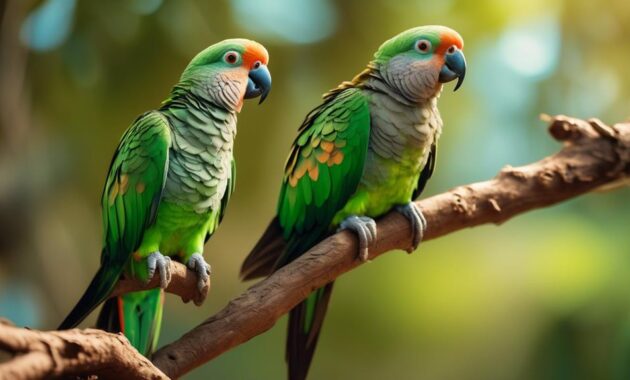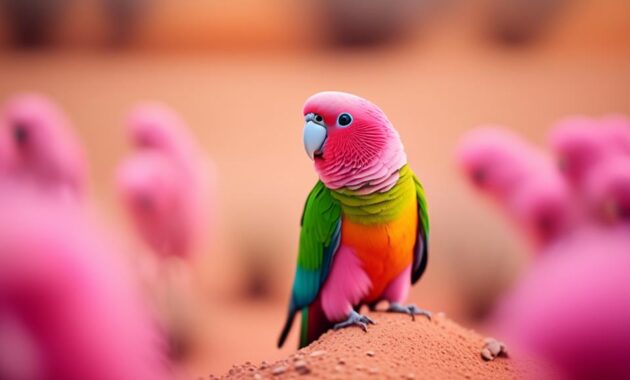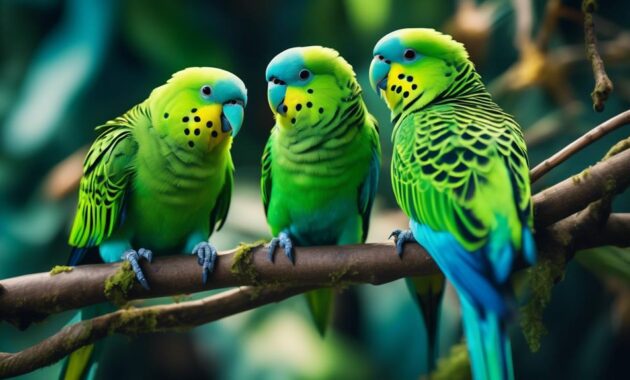
Have you ever wondered how a bird could possess such captivating mimicry skills? Well, the Black Headed Caiques might just hold the answer.
These colorful parrots have gained a reputation for their ability to imitate sounds, but is it a mere coincidence or something more? Prepare to be intrigued as we unravel the secrets behind their mimicry talents.
From their distinct physical characteristics to their vibrant and social nature, there's much more to discover about these captivating birds.
So, get ready to delve into the fascinating world of Black Headed Caiques and uncover the truth behind their nature's colorful mimics.
Key Takeaways
- Black Headed Caiques are medium-sized parrots known for their stubby, robust look and comical appearance with ruffled, puffy white chest and belly feathers.
- They are intelligent, inquisitive, and playful birds, often found in noisy, colorful flocks.
- Black Headed Caiques have a lifespan of 25-40 years and are considered good long-term companion pets.
- They are native to the Amazon region of northern South America and prefer humid, tropical rainforests as their habitat. They are known for their talent in mimicking sounds, including alarms, sirens, beeps, and animal sounds.
Physical Characteristics and Behavior
Black Headed Caiques are medium-sized parrots with a stubby, robust appearance and a playful nature. These birds can grow up to 10 inches in length and have short tail feathers. They've ruffled, puffy white chest and belly feathers, which give them a comical look.
Males and females are identical, making it difficult to tell them apart. Black Headed Caiques are intelligent, inquisitive, and known for their playful behavior. They're social birds that live in noisy, colorful flocks. These parrots have a talent for mimicking sounds and can even create new patterns or words by combining different sounds.
With their lively and entertaining nature, Black Headed Caiques make great companion pets.
Lifespan and Care

Caiques, like the Black Headed Caique, have a lifespan of 25-40 years and make excellent long-term companion pets. When caring for a Black Headed Caique, there are a few important factors to consider:
- Diet and Nutrition:
- Provide a varied diet consisting of high-quality pellets, fresh fruits, and vegetables.
- Avoid foods that are high in fat, sugar, or salt.
- Offer treats sparingly to maintain a balanced diet.
- Environmental Needs:
- Provide a spacious cage with plenty of room for exercise and play.
- Offer a variety of toys and mental stimulation to keep them entertained.
- Provide a warm and comfortable environment, avoiding drafty or cold areas.
Bird Species and Comparison

When considering different bird species, it's worth noting the Black Headed Caique isn't the only beloved parrot in the Caique family. Another comparable breed is the White-bellied Caique.
Like the Black Headed Caiques, White-bellied Caiques are known for their lovely colors and quirky behavior. They're also loved as pet birds worldwide.
However, there are some differences between the two species. Black Headed Caiques have a black head and bright orange feathers on their belly, while White-bellied Caiques have a white head and bright yellow feathers on their belly.
Despite these differences, both species share similar characteristics such as their playful nature, intelligence, and talent for mimicking sounds.
Whether you choose a Black Headed Caique or a White-bellied Caique, you can be sure to have a captivating and colorful companion.
Native Region and Habitat

Native to the Amazon region of northern South America, the natural habitat of the Black Headed Caique consists of humid, tropical rainforests in countries like Venezuela, Colombia, Peru, Bolivia, and more. In this diverse and vibrant environment, these parrots thrive in the treetops of the Amazonian forests.
Here are some key details about their native region and habitat:
- Location: Black Headed Caiques can be found in the Amazon region of northern South America, specifically in countries like Venezuela, Colombia, Peru, and Bolivia.
- Habitat: They prefer humid, tropical rainforests as their natural habitat.
- Grouping: Black Headed Caiques live in noisy, colorful flocks consisting of 10 to 30 birds.
- Tree-dwellers: They inhabit the treetops of the Amazonian forests, where they can find food, shelter, and safety.
- Biodiversity: The Amazon rainforest is one of the most biodiverse places on Earth, providing a rich variety of plant species and food sources for the Black Headed Caiques.
In this lush and vibrant environment, the Black Headed Caiques are perfectly adapted to thrive and display their captivating colors and mimicry skills.
Vocalization and Sounds

As we shift our focus to the fascinating vocalization and sounds of the Black Headed Caiques, prepare to be amazed by their inquisitive nature and remarkable talent for mimicking various sounds.
These colorful parrots surprise with their whistling, vocal, and noisy sounds. They've the ability to mimic alarms, sirens, beeps, and even animal sounds. It's truly astonishing to hear them create such realistic imitations.
Their talent for mimicking sounds isn't only entertaining but also a reflection of their intelligence and adaptability. Whether it's the sound of a ringing phone or the chirping of a bird, Black Headed Caiques can accurately replicate it.
Their vocalization skills make them unique and captivating companions, adding a lively and interactive element to their already charming personality.
Diet and Feeding Habits

To maintain the optimal health of Black Headed Caiques, it's important to understand their dietary needs and feeding habits. These vibrant parrots have specific requirements to ensure their well-being. Here are the key points to consider:
- Diet
- Provide a balanced diet that includes a variety of fresh fruits and vegetables.
- Offer high-quality pelleted food as the main component of their diet.
- Feeding Habits
- Offer food in small portions throughout the day to mimic their natural foraging behavior.
- Provide enrichment activities such as puzzle toys to stimulate their minds during mealtime.
Breeding and Nesting Behavior

Now let's explore the breeding and nesting behavior of Black Headed Caiques, shedding light on their reproductive habits and nesting preferences.
Black Headed Caiques reach sexual maturity at around 3 to 4 years of age. During the breeding season, which typically occurs between December and April, these birds form monogamous pairs and engage in courtship rituals. Males display their vibrant plumage and perform acrobatic flights to attract females.
Once a pair has formed, they search for a suitable nesting site. Black Headed Caiques prefer to nest in tree cavities or termite mounds, using their strong beaks to excavate and shape the nest. The female lays a clutch of 2 to 4 eggs, which she incubates for about 24 to 26 days.
Both parents take turns incubating the eggs and feeding the chicks. The chicks fledge after around 8 to 10 weeks and become independent shortly after.
Training and Socialization

Training and socialization are crucial aspects of raising Black Headed Caiques, ensuring their well-being and fostering a strong bond between these intelligent birds and their human companions. To effectively train and socialize these colorful mimics, consider the following:
- Training:
- Start with basic commands like 'step up' and 'step down' to establish trust and cooperation.
- Use positive reinforcement techniques, such as treats and praise, to encourage desired behaviors.
- Gradually introduce more complex tricks and behaviors, like fetching or waving, to stimulate their intelligent minds.
- Socialization:
- Expose your Black Headed Caique to various environments, people, and other animals to avoid fear or aggression.
- Provide plenty of toys and mental stimulation to prevent boredom and destructive behaviors.
- Engage in regular interactive playtime to strengthen the bond and build trust with your feathered friend.
Health and Common Diseases

Taking care of the health of your Black Headed Caique is crucial to ensure their well-being and longevity. These vibrant parrots are generally hardy and robust, but they're still susceptible to certain common diseases.
One of the most common health issues seen in Black Headed Caiques is feather plucking or self-mutilation. This can be caused by various factors such as stress, boredom, or improper diet.
Regular veterinary check-ups are essential to catch any potential health problems early on. Additionally, maintaining a clean and hygienic environment for your bird, providing a balanced diet, and ensuring regular exercise and mental stimulation are all important aspects of keeping your Black Headed Caique healthy and happy.
Tips for Keeping Them as Pets

To ensure a fulfilling experience as a pet owner, here are some essential tips for caring for Black Headed Caiques:
- Housing and Environment
- Provide a spacious cage with plenty of room for exercise and play.
- Include perches and toys to stimulate their active nature.
- Create a warm and comfortable environment with proper temperature and lighting.
- Diet and Nutrition
- Offer a balanced diet consisting of high-quality pellets, fresh fruits, and vegetables.
- Provide a variety of foods to prevent boredom and ensure nutritional needs are met.
- Avoid feeding them toxic foods like chocolate, caffeine, and avocado.
Remember to spend quality time with your Black Headed Caique, as they thrive on social interaction and mental stimulation.
Regular veterinary check-ups and a clean living space are also important for their overall well-being.
With proper care and attention, these captivating parrots will bring joy and entertainment to your life for many years.
Legalities and Regulations

Legalities and regulations surrounding the ownership of Black Headed Caiques vary depending on your location. Before considering getting a Black Headed Caique as a pet, it's important to research and understand the laws and regulations in your area.
In some places, owning these birds may require permits or licenses. Additionally, there may be restrictions on importing or exporting them across borders. It's crucial to comply with these legal requirements to ensure the well-being of the birds and avoid any legal consequences.
Some countries may also have specific guidelines regarding the care and housing of exotic bird species. It's recommended to consult local authorities or avian experts to ensure that you're adhering to the appropriate regulations and providing a suitable environment for your Black Headed Caique.
Caique Ownership Stories and Experiences

After familiarizing yourself with the legalities and regulations surrounding the ownership of Black Headed Caiques, it's time to explore the fascinating world of caique ownership stories and experiences.
- Heartwarming stories:
- Owners have shared stories of their caiques forming deep bonds with them and becoming cherished members of their families.
- Some caiques have shown remarkable intelligence and problem-solving skills, surprising their owners with their ability to learn tricks and solve puzzles.
- Hilarious anecdotes:
- Many owners find themselves entertained by their caiques' playful antics and mischievous behavior.
- Caiques are known for their comical dances, silly head movements, and amusing vocalizations that can bring laughter to any household.
Caique ownership is a rewarding experience filled with joy and laughter. These colorful little mimics have a way of captivating their owners and brightening their lives with their vibrant personalities.
Conservation Efforts and Initiatives

Conservation efforts and initiatives play a crucial role in protecting the habitat and population of Black Headed Caiques. These colorful parrots are native to the Amazon region of northern South America, where they inhabit the treetops of tropical rainforests.
Unfortunately, their natural habitat is under threat due to deforestation and illegal pet trade. To safeguard their future, various conservation organizations and initiatives have been working tirelessly to raise awareness about the importance of preserving their habitat and the need to combat illegal wildlife trafficking.
These efforts include funding research projects, implementing conservation programs, and advocating for stronger laws and regulations. By supporting these initiatives and promoting responsible pet ownership, we can contribute to the protection and conservation of the beautiful Black Headed Caiques and ensure their survival for generations to come.
Frequently Asked Questions
How Do Black Headed Caiques Communicate With Each Other in Their Flocks?
Black Headed Caiques communicate with each other in their flocks through vocalizations and sounds. They can mimic alarms, sirens, beeps, and even other animal sounds, showcasing their inquisitive and talented nature.
Are Black Headed Caiques Known for Any Specific Behaviors or Antics?
Yes, black-headed caiques are known for their playful and mischievous behavior. They love to entertain and amuse with their acrobatics, dancing, and mimicry. Their comical antics make them captivating and endearing pets.
Can Black Headed Caiques Be Trained to Talk or Mimic Specific Sounds?
Yes, black headed caiques can be trained to talk and mimic specific sounds. Their intelligent and inquisitive nature, combined with their talent for mimicking sounds, allows them to learn and imitate a wide range of sounds and words.
Do Black Headed Caiques Require Any Specific Diet or Feeding Habits?
Black Headed Caiques require a specific diet and feeding habits to stay healthy. They need a balanced diet of fruits, vegetables, seeds, and pellets. Providing fresh water and occasional treats is also important for their well-being.
Are There Any Unique Health Concerns or Common Diseases That Black Headed Caiques Are Prone To?
There aren't any unique health concerns or common diseases that black headed caiques are prone to. However, it's important to provide them with a balanced diet, regular vet check-ups, and a clean environment to ensure their overall well-being.
What Makes Black Headed Caiques Unique Compared to Blue Crowned Conures?
Black Headed Caiques are known for their playful and mischievous nature, making them popular pets among bird enthusiasts. They are recognized for their vibrant feathers and energetic personality. In comparison, vibrant blue crowned conures are known for their intelligence and ability to mimic human speech. Both species have unique characteristics that make them popular choices for bird lovers.
Conclusion
So, if you're looking for a vibrant and entertaining companion, look no further than the Black Headed Caiques.
With their unique physical characteristics, playful behavior, and impressive mimicry skills, these parrots are sure to captivate bird enthusiasts.
Their long lifespan and hardy nature make them great long-term companions.
Whether you're a bird lover or considering them as pets, the Black Headed Caiques will surely bring color and joy to your life.
Don't miss the opportunity to witness nature's colorful mimics in action.




